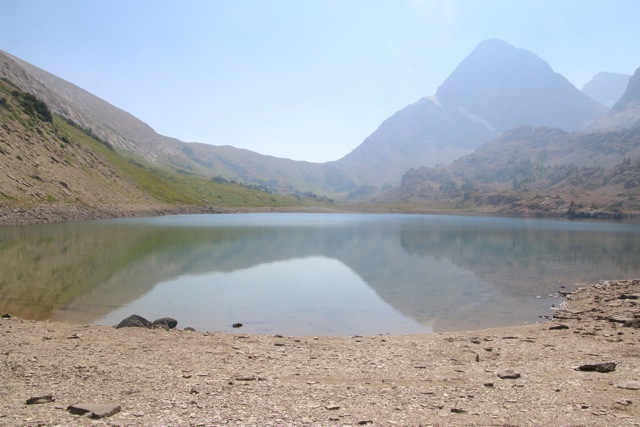
Looking north from North Fork Pass (2425m) over the upper Panther River valley. Gavin Fitch photo.
Every once in awhile, one of our contributors comes up with a better itinerary than what we feature in the Canadian Rockies Trail Guide. That happened this month when Gavin Fitch sent us a report on his seven-day trip this August along Banff’s Sawback Range.
We write-up the Sawback Trail as a fairly direct 73-km trip from Mount Norquay to Lake Louise via Mystic, Pulsatilla and Boulder Passes. But Gavin’s party followed a more remote variation, hiking via Forty Mile Summit, Flint’s Park, Badger Pass, Pulsatilla Pass, Skoki Valley and Deception Pass.
They added a couple side trips into the itinerary (North Fork Pass and Skoki), which brought their total distance up to 115 km. But had they simply used the Forty Mile Summit-Flints Park-Badger Pass variation, their trip would’ve totalled 75.5 km—just 2.5 km more than the standard route.
Personally, I would gladly trade Mystic Pass and Luellen Lake for Rainbow Lake, Flint’s Park, and Badger Pass (plus a side-trip to North Fork Pass). Check out Gavin’s description of his 7-day trip:
Sawback Trail Trip Report
by Gavin Fitch
We started at Norquay and spent the first night at Mystic Pass Junction. The first junction with the Elk Lake trail is not signed and easy to miss–we sailed by it, crossed the bridge and got as far as the Cascade Amphitheatre trail. What idiots. Anyway, not only is the junction not signed, the “connector trail” that runs along the south bank of Forty Mile is pretty rough–I’m guessing the old trail must have been washed out in a flood. From the bridge crossing on, you’re back on the horse trail and everything is straightforward.
From Mystic Pass Junction we carried on up to Forty Mile Summit and took the trail to Rainbow Lake, which splits from the main trail not far after reaching the summit. It’s an extra 100m or so of elevation gain but so worth it. The lake is gorgeous, set in a larch-filled bowl at the base of a classic Front Ranges peak. The walk down from the lake to Flint’s Park is also very cool, as it tracks the edge of an escarpment, affording great views north across the Sawback valley.
We spent two nights at Flint’s Park and absolutely loved it. What a great campsite, in that broad and open confluence of three valleys–and it’s a good place to find a little solitude: we had it all to ourselves.
Did a day hike on Day 3 up to North Fork Pass. We found the trail to be easy to follow, though there are 3 fords along the way that are difficult to get across without getting your boots wet. The view from the pass down into the Panther valley is pretty awesome–a precipitous drop into a very remote and lonely-looking valley.
On Day 4 we headed west over Badger Pass. Now that’s a serious climb. We lucked out with the weather as it was sunny and glorious at the pass. We were pretty beat from the climb and really looking forward to making camp that night.
Where the Badger Pass trail meets the Sawback trail a sign says the campsite is 0.5 km. But beware! Another unsigned junction–once again we sailed past it and walked an extra km or so up the trail. Turns out there are two trails running up the Johnston Creek valley in that area: the one we were on, which is farther from the creek (east) and more in the trees; and the other which runs through the open meadow. The campground (Badger Pass Junction) is between the two trails but the sign for the campsite is not on the trail. Oh well.

Pulsatilla Lake and Pass. Gavin Fitch photo.
The climb over Pulsatilla Pass the next day was short (we followed the trail by the creek in the centre of the meadows) and we had a wonderful lunch at Pulsatilla Lake on the other side of the pass. What a gorgeous spot. From there we carried on to Wildflower campground, which we really liked. The name had us thinking it would be in meadows, but actually it’s in a small clearing in an old growth forest–tall trees and Wildflower Creek roaring by. Very zen.
Day 6 we carried on to Skoki and Merlin Meadows. Somehow we missed the junction (you see a pattern emerging here) with the trail that cuts around the north flank of Fossil Mountain to go to Skoki, and instead ended up at the second junction, on the south flank of Skoki Mountain. Afternoon tea (read: beer) at the lodge made up for that faux pas.
Our final day, Day 7, we did the classic walk out to Lake Louise over Deception Pass. It was a wonderful hike. We all agreed that from Rainbow Lake on Day 2 to Merlin Meadows on Day 6 the scenery was pretty fantastic the whole way. Including the day hike to North Fork Pass, we clocked it in at about 115 km.
Gavin

Some notes about Forty Mile: Just got back from touring the area (Jul 11 – 13, ’22); 2 nites at FM19 “basecamp”, central day with light pack to Sawback Lake then looped back via Flint trail to Rainbow Lake and back to 40 Mile/FM19. This is outstanding alpine area, and seldom visited Rainbow Lake steals the show.
Rainbow Lake is rimmed by larches and would make outstanding late September destination. Also note the ridge rising above the lake: It is an easy walk-up and would provide fantastic aerial panorama of the area. According to Parks Canada in 2015 they flew batch of Westslope Cutthroat Trout from Sawback lake to Rainbow Lake in attempt to preserve one of BNP native fish species (https://www.pc.gc.ca/en/pn-np/ab/banff/nature/conservation/aquatics/restoring/rainbow)